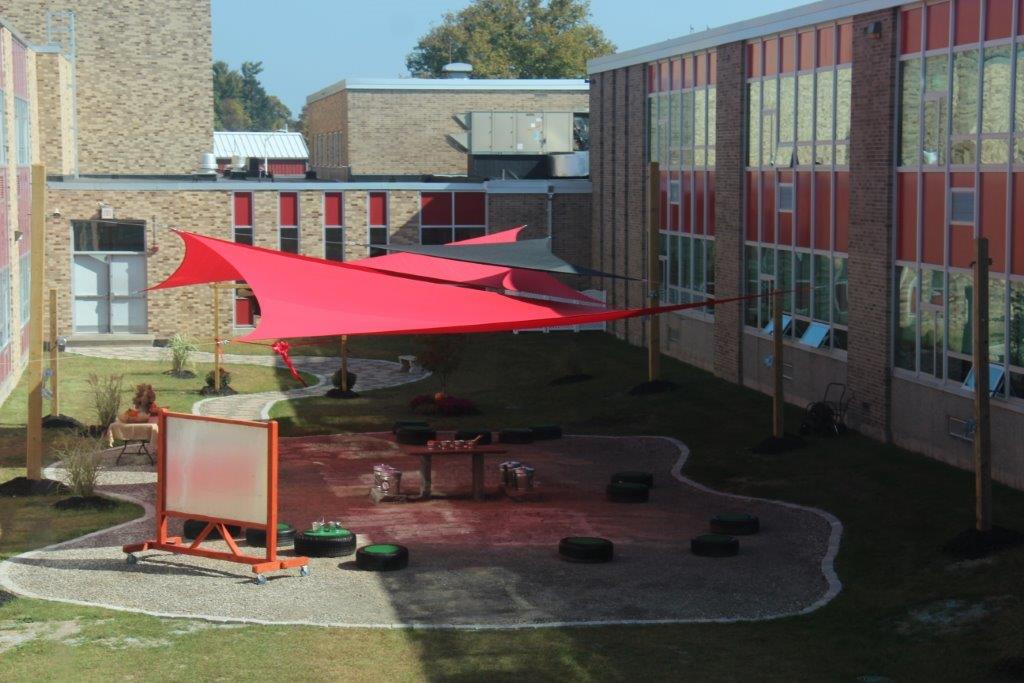Peaceful Learning in Outdoor Spaces
By Karen L. Schneider Communicator August 2014, Volume 37, Issue 12
By Karen L. Schneider
Communicator
August 2014, Volume 37, Issue 12
Think of the last time you’ve come upon a peaceful outdoor setting that stopped you in your tracks with its beauty and serenity. Maybe you felt a heightened awareness of your senses—hearing birds singing, seeing the blue of a crystal-clear, mid-morning sky, smelling the aroma of pine needles. In calm outdoor settings, we tend to listen more carefully, and observe with greater focus and heightened awareness. Outdoor classrooms can provide students with powerful, memorable learning experiences like these.
Rethinking Learning Environments
Educational environments impact students’ emotions, brains, and potential for learning. For instance, Denmark—a country with an education system thought to be among the best worldwide—introduced in 2001the Act on Educational Environment for Pupils and Students. This act puts students’ learning environment high on the list of priorities when schools are built or remodeled. Heightened learning can occur in places where students and teachers feel comfortable and relaxed. Aesthetically pleasing outdoor areas—spaces with openness, water, landscaping, and sunlight—particularly appeal to the senses.
 Building Our Classroom
Building Our Classroom
The most unique space at my school, Anna S. Kuhl Elementary School in Port Jervis, New York, is our outdoor learning classroom. This space started out as an unused courtyard. But that changed last summer. Our principal, Brett Cancredi, and assistant principals Matthew Wentworth and Nicole Ey shared a vision to expand instructional space and boost student learning. The artistically creative Ey spearheaded and designed the project. We received a $5,000 grant from Lowe’s Toolbox for Education program, and community members and businesses donated other items, such as stones, flowers, plants, decorative metal artwork, and recycled tires. Volunteers from our school staff, the community, and athletes from the Port Jervis High School football team worked throughout last summer to shape the space and make Ey’s vision a reality.
With a winding stone pathway beneath their feet, students enter the outdoor classroom through a wooden arch. Sails overhead (in the school colors of red and black) shade students from the sun. Inside, a stone table and seats made of recycled tired are ready for students’ and teachers’ use.
 New Learning Experiences
New Learning Experiences
In this outdoor classroom, our K-6 school’s 900 students have learned about virtually every subject: art and music, reading, language arts, social studies, science, and math.
When the outdoor classroom opened, the first students to experience it were the kindergarteners, who entered the space with awe and excitement. Their first lesson was about trees, and students rotated to stations where they explored natural objects (hands-on), added descriptive words to a basic sentence, listened to a story about trees, and drew their own versions of natural objects on paper.
These young students were not only thoroughly engaged during their lesson, but were also able to internalize the concept that learning takes place everywhere, and is not to be confined to a classroom. We hope that students can take this newfound awareness home with them and begin to consciously learn in all sorts of locations—sometimes places where they would least expect to learn.
A group of sixth-graders experienced the outdoor classroom next for a math lesson on ratios. Math and the outdoor space have worked well together: shapes and distances, for instance, can seem less abstract when they can be explored outside instead of just on paper.
As the school year continued, nutrition lessons were held in the classroom, in conjunction with our local ShopRite. Students tasted fruits and vegetables as they studied the human body. Sixth-graders dissected owl pellets and were able to learn about digestion and anatomy. (What better place than an outdoor classroom for contemplating birds?) Students have also written and created art pieces outdoors, the natural light enhancing students’ recognition of space, line, and color, and the peaceful setting encouraging creativity.
As more students, teachers, and visitors frequent this unique oasis, we hope it can reinforce the idea that knowledge is boundless, and that learning is as important to our souls as well as our minds.
Lessons for Educators
When creating an outdoor learning space, keep these tips in mind.
- Have a vision for the space.
- Build and show sustained enthusiasm for the project. Be 100 percent committed to the project from beginning to end.
- Design your classroom with your goals and objectives in mind.
- Collaborate with and involve teachers and students throughout the project.
- Engage your community by explaining the project and its benefits. Perhaps community members could offer volunteer time or materials.
- Make a thorough and realistic budget.
- Set up volunteer days with a description of the work to be done so that volunteering can be flexible and effective.
- Encourage the use of the space by all students and classes. Small reading groups, special area classes, guidance groups, guest speakers, student councils, and clubs should know that the space is available to them as well as to the classroom teachers. Post a sign-up form near the entrance so that teachers can reserve the space ahead of time.
- Continue to share your vision and enthusiasm with your stakeholders.
Karen L. Schneider is a reading teacher and reading coordinator at Anna S. Kuhl Elementary School in Port Jervis, New York.
—
Copyright © 2014. National Association of Elementary School Principals. No part of the articles in NAESP magazines, newsletters, or website may be reproduced in any medium without the permission of the National Association of Elementary School Principals. For more information, view NAESP’s reprint policy

